语言学期末考试试题
语言学期末考试试题

语言学期末考试试题一、选择题(每题 2 分,共 30 分)1、语言的本质属性是()A 社会性B 生理性C 物理性D 心理性2、下列属于音素的是()A aiB pC auD ei3、汉语普通话中“妈”“麻”“马”“骂”的声调不同,主要是由于()A 音高B 音强C 音长D 音色4、最小的有意义的语言单位是()A 语素B 词C 短语D 句子5、“巧克力”是()A 单纯词B 合成词C 派生词D 复合词6、下列词中属于偏正结构的是()A 提高B 黑板C 心疼D 地震7、“他跑得很快”中“得”的作用是()A 表示可能B 表示程度C 表示结果D 表示趋向8、下列句子属于兼语句的是()A 他叫我去买东西。
B 我知道他来。
C 他有个妹妹很可爱。
D 大家选他当班长。
9、下列属于外来词的是()A 电脑B 沙发C 电话D 电视10、语言发展的基本条件是()A 社会的发展B 语言内部的矛盾C 不同语言的接触D 个人的创造11、现代汉民族共同语是以()为标准音。
A 北京语音B 北方语音C 南京语音D 广州语音12、下列方言中属于吴方言的是()A 上海话B 厦门话C 南昌话D 长沙话13、语言融合的方式通常是()A 自愿融合B 被迫融合C 自然融合D 人工融合14、下列语言中属于屈折语的是()A 汉语B 英语C 日语D 朝鲜语15、语言符号的任意性是指()A 语言符号的形式和意义之间没有必然联系B 语言符号的形式和意义之间存在必然联系C 语言符号可以随意改变形式和意义D 语言符号的形式和意义是固定不变的二、填空题(每题 2 分,共 20 分)1、语言是人类最重要的________工具和________工具。
2、语音四要素包括音高、音强、音长和________。
3、元音和辅音最主要的区别是________。
4、词的组合的五种基本类型是主谓结构、动宾结构、偏正结构、中补结构和________。
5、句子按语气可以分为陈述句、疑问句、祈使句和________。
语言学期末考试题及答案
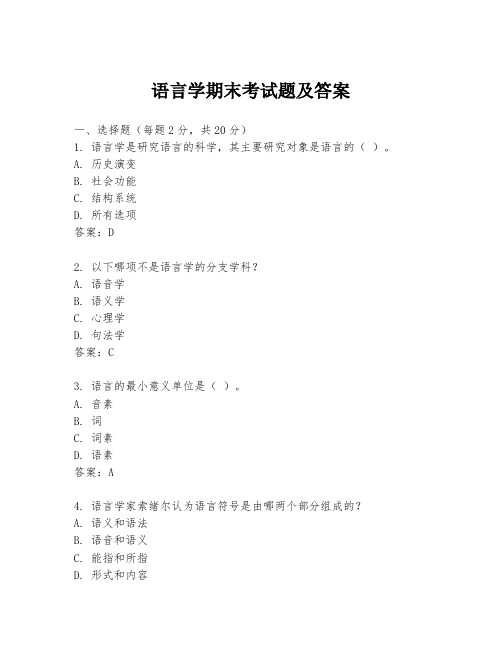
语言学期末考试题及答案一、选择题(每题2分,共20分)1. 语言学是研究语言的科学,其主要研究对象是语言的()。
A. 历史演变B. 社会功能C. 结构系统D. 所有选项答案:D2. 以下哪项不是语言学的分支学科?A. 语音学B. 语义学C. 心理学D. 句法学答案:C3. 语言的最小意义单位是()。
A. 音素B. 词C. 词素D. 语素答案:A4. 语言学家索绪尔认为语言符号是由哪两个部分组成的?A. 语义和语法B. 语音和语义C. 能指和所指D. 形式和内容5. 以下哪个选项是语言的交际功能?A. 信息传递B. 表达情感C. 思考工具D. 所有选项答案:D6. 语言的音位系统是由()决定的。
A. 社会约定B. 个人习惯C. 物理属性D. 语法规则答案:A7. 以下哪个不是语言的变异现象?A. 方言B. 社会方言C. 语言混合D. 语言的稳定性答案:D8. 语言的词汇系统包括()。
A. 词根B. 词缀C. 词D. 所有选项答案:D9. 语言的语法系统包括()。
B. 词法C. 音位学D. 所有选项答案:D10. 以下哪项是语言的内部因素?A. 社会因素B. 心理因素C. 语言接触D. 语言的规则性答案:D二、填空题(每题2分,共20分)1. 语言学研究的对象是______,研究的方法是______。
答案:语言;科学的方法2. 语言的音位系统是由______决定的,而词义系统是由______决定的。
答案:社会约定;社会约定3. 语言的最小意义单位是______,而最小的语音单位是______。
答案:语素;音素4. 索绪尔将语言符号分为两个部分:______和______。
答案:能指;所指5. 语言的交际功能包括信息传递、表达情感和______。
答案:思考工具6. 语言的变异现象包括方言、社会方言和______。
答案:语言混合7. 语言的词汇系统包括______和______。
答案:词根;词缀8. 语言的语法系统包括______和______。
语言学期末考试
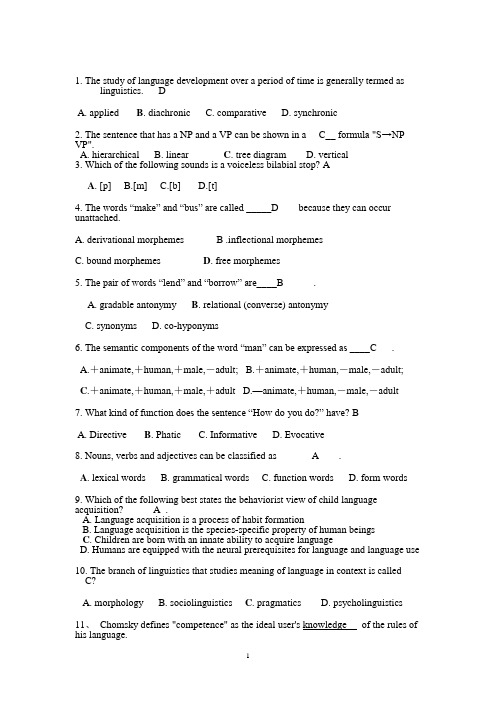
1. The study of language development over a period of time is generally termed as_____linguistics. DA. appliedB. diachronicC. comparativeD. synchronic2. The sentence that has a NP and a VP can be shown in a __C__ formula "S→NP VP".A. hierarchicalB. linearC. tree diagramD. vertical3. Which of the following sounds is a voiceless bilabial stop? AA. [p]B.[m]C.[b]D.[t]4. The words “make” and “bus” are called _____D____because they can occur unattached.A. derivational morphemes B .inflectional morphemesC. bound morphemesD. free morphemes5. The pair of words “lend” and “borrow” are____B______.A. gradable antonymyB. relational (converse) antonymyC. synonymsD. co-hyponyms6. The semantic components of the word “man” can be expressed as ____C___.A.+animate,+human,+male,-adult;B.+animate,+human,-male,-adult;C.+animate,+human,+male,+adultD.—animate,+human,-male,-adult7. What kind of function does the sentence “How do you do?” have? BA. DirectiveB. PhaticC. InformativeD. Evocative8. Nouns, verbs and adjectives can be classified as_______A____.A. lexical wordsB. grammatical wordsC. function wordsD. form words9. Which of the following best states the behaviorist view of child language acquisition?______A_.A. Language acquisition is a process of habit formationB. Language acquisition is the species-specific property of human beingsC. Children are born with an innate ability to acquire languageD. Humans are equipped with the neural prerequisites for language and language use10. The branch of linguistics that studies meaning of language in context is called__C?A. morphologyB. sociolinguisticsC. pragmaticsD. psycholinguistics11、Chomsky defines "competence" as the ideal user's knowledge of the rules of his language.12、The four sounds /p/,/b/,/m/ and /w/have one feature in common, i.e, they are all bilanial .13、Morphology is a branch of grammar which studies the internal structure of words and the rules by which words are formed.14、A sentence is a structurally independent unit that usually comprises a number of words to form a complete statement, question or command.15、In most b communities, two languages have the same in speech situations known as domains.16、The illocutionary point of r is to commit the speaker to something's being the case, to the truth of what has been said.17、.In the history of any language the speech____ form always came into being before the writing system.18--19、Syntactic categories refer to s ( ) and c ( ) only.20、As a type of linguistic system in L 2 learning, interlanguage is a product of L2 training, mother tongue interference, overgeneralization of the target language rules, and learning and communicative strategies of the learner.( F )21、In modern linguistic studies, the written form of language is given more emphasis than the spoken form for a number of reasons.( F )22、Voicing is a phonological feature that distinguishes meaning in both Chinese and English.( T)23、The compound word "bookstore" is the place where books are sold. This indicates that the meaning of a compound is the sum total of the meanings of its components.( T)24、The territory in which the Indo-European languages are mainly spoken today also includes languages that are not Indo-European.( F)25、All normal children have equal ability to acquire their first language.IV. 1. Give the phonetic symbol for each of the following sound descriptions: Symbols here in order:26. [t∫]27 [б]28. [d]29.[I]30. [э:]1) voiceless, palatal, affricate 2) voiced, dental, fricative3) voiced, alveolar, stop 4) open, close, short5) back, semi-open, long2. Give the phonetic features of each of the following sounds31 [m]32[r]33[e]34[w]35[h]31 [m]voiced, bilabial, nasal; 32[r]voiced, alveolar, liquid;33[e]front, high, semi-close; 34[w]voiced, bilabial, glide;35[h]voiceless,fricatives,glottal;V. The following sentences all contain conjoined categories. Draw a treediagram for each of the sentences:1.Mary is fond of literature but tired of statistics.2.The detective went out and the mysterious man came in..Answer the following questions as comprehensively as possible:1.What criteria are used to classify the English vowels?The criteria used to classify English vowels are:The height of the tongue raising: high, mid, and lowThe position of the highest part of the tongue: front, central, and backThe degree of lip rounding: rounded, un-roundedThe degree of tenseness/the length of sound: tense (long) or lax (short)The change of sound quality: pure (monophthong), gliding (diphthong)2 What are the four maxims of CP (Cooperative Principle)?The Cooperative PrincipleThe maxims are:Quantity: Make your contribution as informative as is required (for the current purposes of the exchange). Do not make your contribution more informative than is required.Quality –Try to make your contribution one that is true.Do not say what you believe to be false.Do not say that for which you lack adequate evidence.Relation – Be relevant.Manner – Be perspicuous. Avoid obscurity of expression. Avoid ambiguity. Be brief (avoid unnecessary prolixity). Be orderly.Explain what pragmatics studies for and how it differs from traditional semantics.A general definition: pragmatics is the study of language in use.Pragmatics studies the factors that govern our choice of language in social interaction and the effects of our choice on others. Pragmatics takes care of the aspect of meaning that is not accounted for by semantics. Semantics traditionally deals with meaning as a dyadic relation, while pragmatics deals with meaning as a triadic relation. Thus meaning in pragmatics is defined relativeto a speaker or the user of the language; whereas meaning in semantics is defined purely as a property of expressions in a given language, in abstraction from particular situations, speakers or hearers.’ Therefore, what essentially distinguishes semantics and pragmatics is whether in the study of meaning the context of use is considered. If it is not considered, the study is restricted to the area of traditional semantics; if it is considered, the study is being carried out in the area of pragmatics.To analyze the language acquisition theories you’ve learned in classes, which one do you think is more reasonable and convincing? Explain why?II. Read each of the following statements carefully. Decide which one of the four choices best completes the statement and put the letter A, B, C or D in the brackets. (2%×10=20%) (Omit)11. 12 .13 14. 15. 16. 17. 18. 19. 20.。
期末语言学试题及答案

期末语言学试题及答案第一部分:选择题1. 下列哪个属于语言学的研究范畴?a) 文学作品的分析b) 语言文字的演变c) 心理学的实验d) 数学公式的推导答案:b) 语言文字的演变2. “语言是人类所特有的交流工具”这句话表达了以下哪个语言学观点?a) 脱离人类语言的存在b) 语言的多样性c) 语言与文化的关联性d) 语言的外在表现形式答案:a) 脱离人类语言的存在3. 以下哪个属于双关语?a) “有钱人终成眷属”b) “真理只能通过实践来证明”c) “独立自主,自由自在”d) “一叶知秋”答案:c) “独立自主,自由自在”4. 以下哪个是语义学的研究范畴?a) 语音学b) 词汇学c) 句法学d) 语用学答案:b) 词汇学5. 下列哪个不属于语言学基本假设?a) 语言是有限的b) 语言与思维密切相关c) 语言学研究应遵循科学原则d) 语言的起源来自上帝的创造答案:d) 语言的起源来自上帝的创造第二部分:简答题1. 解释语言变体的概念,并举例说明。
语言变体指的是不同于标准语的语言变体形式,通常由地理、社会、文化等因素引起。
例如,在中国普通话的基础上,各地方言就是语言的一个变体。
同时,在不同社会群体中,也存在着年龄、职业、阶层等因素引发的语言变体。
例如,年轻人之间的网络流行语和老年人之间的特定方言就是不同的语言变体。
2. 请介绍一下语音学的研究内容。
语音学是语言学的一个分支,主要研究语音的产生、传播和接收过程,以及语音在不同语言之间的差异和共性。
它涉及到元音、辅音等语音单位的分类和描述,以及语音的声音特征、语音规律和变体等课题。
语音学的研究方法包括实地采集语音数据、记录音频,以及使用仪器设备进行分析和测量等。
第三部分:论述题请论述语用学在社会交际中的重要性。
语用学是研究语言使用的学科,它关注的是言语行为和语境对语言意义的影响。
在社会交际中,语用学发挥着重要的作用。
首先,语用学可以帮助人们理解和解释说话者的真实意图。
大学语言类期末考试题及答案

大学语言类期末考试题及答案一、选择题(每题2分,共20分)1. The word "phenomenon" is most closely related to which of the following?A. PhenomenalB. PhenomenalizeC. PhenomenologyD. Phenomenonize答案:C2. Choose the correct translation for "ephemeral" in Chinese.A. 永恒的B. 短暂的C. 永恒的D. 永恒的答案:B3. Which of the following is NOT a function of language?A. CommunicationB. ExpressionC. EntertainmentD. Storage答案:C4. The phrase "to be on cloud nine" typically means:A. To be very high upB. To be very happyC. To be very sadD. To be very confused答案:B5. The term "dialect" refers to:A. A type of foodB. A type of musicC. A type of languageD. A type of clothing答案:C6. What is the past tense of "write"?A. WroteB. WritesC. WritingD. Writed答案:A7. The word "altruism" is opposite to:A. EgotismB. AltruismC. EgalitarianismD. Egalitarian答案:A8. The idiom "to break the ice" means:A. To start a conversationB. To make a decisionC. To end a relationshipD. To make a mistake答案:A9. The word "pragmatic" is most closely associated with:A. PracticalB. TheoreticalC. ImaginativeD. Emotional答案:A10. The phrase "to be in the pink" means:A. To be very wellB. To be very tiredC. To be very angryD. To be very sad答案:A二、填空题(每空2分,共20分)11. The word "____" means "a person who is very careful with money."答案:Miser12. The phrase "____" is used to describe someone who is very cautious.答案:Play it safe13. "____" is the term used to describe a person who is always ready to help others.答案:Good Samaritan14. The word "____" can be used to describe a person who is very talkative.答案:Garrulous15. "____" is a phrase that means to make a situation better.答案:Improve16. The word "____" is used to describe a person who is very honest.答案:Candid17. "____" is a term that refers to the study of languages.答案:Linguistics18. The phrase "____" means to be very careful with one's words.答案:Choose one's words carefully19. "____" is the term used to describe a person who is very organized.答案:Methodical20. The word "____" can be used to describe a person who is very sensitive to criticism.答案:Thin-skinned三、阅读理解(每题5分,共30分)阅读下面的短文,然后回答问题。
语言专业期末试题及答案

语言专业期末试题及答案一、选择题1.以下哪个选项是对于语言学研究对象的定义最准确的?A. 文字B. 语言C. 语法D. 语音答案:B. 语言2.下面哪个选项是对于语言习得和语言学习的描述最恰当的?A. 语言习得是指通过接触环境中的语言而获得的非有意识的语言能力;语言学习是指通过系统学习而获得的有意识的语言知识和技能。
B. 语言习得和语言学习是同一个概念,指的是通过不同的方式学习和掌握新的语言。
C. 语言习得是指通过系统学习和实践获得的语言能力;语言学习是指通过社交环境中的语言接触而获得的语言技能。
D. 语言习得是指通过无意识接触语言环境而自然习得的语言能力;语言学习是指通过专门的语言课程学习语言技能。
答案:A. 语言习得是指通过接触环境中的语言而获得的非有意识的语言能力;语言学习是指通过系统学习而获得的有意识的语言知识和技能。
3.下列哪个选项是语言层次结构的描述最准确的?A. 语音 - 词汇 - 句子 - 文章B. 词汇 - 句子 - 语音 - 文章C. 文章 - 句子 - 词汇 - 语音D. 语音 - 文章 - 句子 - 词汇答案:A. 语音 - 词汇 - 句子 - 文章4.以下哪一个选项是对于词汇意义最恰当的描述?A. 词汇是用来表达意义和概念的基本单位。
B. 词汇是一种具体的语言形式,用来传达语言信息。
C. 词汇是语言中的规则配对,用来识别特定的语言结构。
D. 词汇是语言中的声音和符号,用来构成句子。
答案:A. 词汇是用来表达意义和概念的基本单位。
5.以下哪个选项是对于语法的定义最准确的?A. 语法是指语言表达的结构、规则和原则。
B. 语法是指一门学科,研究语言的产生和变化。
C. 语法是指语言的音节、词汇和句子的组成规律。
D. 语法是指语言使用中的语音和语义规则。
答案:A. 语法是指语言表达的结构、规则和原则。
二、简答题1.请简要解释语音学的研究范畴。
答:语音学研究的是语音及其相关现象,包括语音的产生、传播和感知等方面。
语言学期末

语言学期末(这份是正确的)(总10页)-本页仅作为预览文档封面,使用时请删除本页-一. What is language?1. Language can be generally defined as a system of arbitrary vocal symbols used for human communication.Systematic---- rule-governed, elements in it are arranged according to certain rules; can’t be combined at will. . *bkli, *I apple eat.Arbitrary---- no intrinsic connection between the word and the thing it denotes, . “pen” by any other name is the thing we use to write with.Symbolic---- words are associated with objects, actions ideas by convention. “A rose by any other name would smell as sweet”----ShakespeareVocal---- the primary medium is sound for all languages; writing system came much later than spoken form.Human-specific---- different from the communication systems other forms of life possess, . bird songs, bee dance, animal cries.The design/defining /distinctive features of human language:Arbitrariness (任意性)Productivity/Creativity(创造性)Duality (二元性、二层性)Displacement (移位性)Cultural transmission(文化传递性)2.语言&言语Langue--- the language system shared by a community of speakersParole--- the concrete act of speaking in actual situations by an individual speaker.3. Synchronic vs. diachronicSynchronic (linguistics)---languages are studied at a theoretic point in time: one describes a ‘state’ of language, disregarding whatever changes might be taking place.Diachronic----languages are studied from point of view of their historical development – for example, the changes which have taken place between Old and Modern English could be described in phonological, grammatical and semantic terms.二.语音学(选择题)三.音位学 Phonology1.音位变体Allophones ---- the phones that can represent a phoneme in different phonetic environments.同一音位在不同环境中表现出来的两个或多个语音上不同的音段. 例如,在英语里,音位/t/在tin里是送气的[th], 在stand里是不送气的[t],在eighth里是齿化的[t],在cotton里是鼻除阻的[tn],在bottle里是边除阻的[tl],在hit里则表现为声门化的[t]. 此外,随着说话人口音的不同,可能还会有其他的语音形式. 这样一套在说话人话语中的语音形式就是音位/t/的音位变体. 把两个音素划归成同一音位的两个音位变体必须满足语音相似性原则,而且它们不能处于对比分布.[p, ph] are two different phones 音子and are variants of the phoneme /p/. Such variants of a phoneme are called allophones of the same phoneme.In this case the allophones are said to be in complementary distribution 互补分布because they never occur in the same context:[p] occurs after [s] while [ph] occurs in other places./p/ [p] / [s] _____[ph] elsewhere2.互补分布Complementary distribution----allophones of the same phoneme are in complementary distribution. They do not distinguish meaning. They occur in different phonetic contexts, .dark [l] & clear [l], aspirated [p] & unaspirated [p].四.形态学**Morphemes: Technically, a morpheme is defined as a minimal meaningful unit in the grammaticalsystem of a components of a word are known as morphemes. They themselves cannot be further analyzed:chairman: chair, mantownhall: town, hallboys: boy, -schecking: check, -ingdisappointment: dis-, appoint, -mentFree morpheme & bound morpheme自由语素和粘着语素Free morpheme----is one that may constitute a word (free form) by itself, such as bed, tree, sing, dance, etc.Bound morpheme----is one that may appear with at least one other morpheme. They can not stand by themselves, such as “-s” in “dogs”, “al” in “national”, “dis-” in “disclose”, “ed” in “recorded”, etc.**Derivational morpheme & inflectional morpheme派生语素和屈折性语素Derivational morphemes---- the morphemes which change the category, or grammatical class of words, . correct---incorrect, edit---co-edit, modern---modernize, length---lengthen, fool---foolish, etc. Inflectional morphemes---- the morphemes which are for the most part purely grammatical markers, signifying such concepts as tense, number, case and so on; they never change their syntactic category, never add any lexical meaning, .a) number: tables matches factoriesb) person, finiteness and aspect: talk/talks/talking/talkedc) case: John/John’sd) comparison: tall/taller/tallest1.构词法 word formation●Compound:smartphone, cutting-edge, domain name, cloakroom 衣帽间, state-of-the-art顶尖的, nursing home, self-control, armchair●Derivation派生法:un + conscious → unconscious,nation + al → national,national + ize → nationalizenationalize + ation → nationalization●Invention(新创词语): Facebook, Twitter, drones, microblog, e-tailer, smartphone, tsunami●Blending(混成法):smoke + fog> smogmotorist + hotel> motelbreakfast + lunch> brunchmodulator + demodulator> modemsmoking + flirting> smirting 边吸烟边跟异性搭讪advertisement + editorial> advertorialeducation + entertainment> edutainmentinformation + commercial> infomercialinformation + entertainment> Infortainment 新闻娱乐化in + love + individual> inlovidual 独立爱人●Abbreviation(缩写词): advertisement--ad; helicopter--copter; influenza--flu●Acronym (缩写词):WB--- World Bank CIA --- Central Intelligence Agency WTO--CPI ---Consumer Price Index 消费者物价指数UNESCO---联合国教科文组织NEET---Not in Education, Employment or Training 啃老族●Clipping(截断法):Back-clippings: ad(vertisement), chimp(anzee),deli(catessen), hippo(potamus), piano(forte),reg(ulation)s, app(lication) program (应用软件)Fore-clippings: (ham)burger, (omni)bus, (violin)cello, (heli)copter,(alli)gator, (tele)phone, (earth)quake.Fore-and-aft clippings: (in)flu(enza), (de)tec(tive).●Back-formation (逆构词法):gangling → gangle editor → editpeddler → peddle hawker → hawkenthusiasm → enthuse laser → lasecalmative → calm free association → free-associate●Analogical creation (类推构词):work: wrought > worked;beseech:besought > beseeched;slay: slew > slayed?●Borrowing (借词): Borrow from other languages.Chinese: kung fu, tea, tofu, typhoon ; Japanese: TsunamiIndian: bungalow, jungle, yoga五.句法学1.画树形图2. Chomsky提出:形式主义的转换生成语法Transformational Generative Grammar、Universal Grammar、 LAD语言习得机制 language acquisition3. 表层结构和深层结构Deep structure & surface structureConsider the following pair of sentences:John is easy to please.John is eager to please.Structurally similar sentences might be very different in their meanings, for they have quite different deep structures.Consider one more sentence: Flying planes can be dangerous.It can mean either that: if you fly planes you are engaged in a dangerous activity or Planes that are flying are dangerous.Deep structure----formed by the XP rule in accordance with the head’s sub-categorization properties; it contains all the units and relationships that are necessary for interpreting the meaning of the sentence.Surface structure----corresponding to the final syntactic form of the sentence which results from appropriate transformations; it is that of the sentence as it is pronounced or written.六.语义学Semanticsis traditionally defined as the study of meaning in language.Types of meaning:●Grammatical meaning●Lexical meaning①Conceptual meaning 概念意义②Association meaning 联想意义a.Connotative meaning 内涵意义b.Social meaning 社会意义c.Affective meaning 情感意义d.Reflected meaning 反射意义e.Collocatinve meaning搭配意义③Thematic meaning 主位意义(1) Conceptual meaning概念意义Also called ‘denotative’(外延的) or ‘cognitive’ meaning.Refers to logical, cognitive or denotative content.Concerned with the relationship between a word and the thing it denotes, or refersto.(2) Connotative meaning(内涵意义)The communicative value an expression has by virtue of what it refers to, over and above its purely conceptual content.(3)Social meaningWhat a piece of language conveys about the social circumstances of its use.(4)Affective meaning(情感意义)Reflecting the personal feelings of the speaker, including his attitude to the listener, or his attitude to something he is talking about.(5) Reflected meaningArises in cases of multiple conceptual meaning, when one sense of a word forms part of our response to another sense.反映意义指的是一个语词或语句除了自身的意义以外还顺带隐射或隐含了其他意义,或联想意义即引起读者联想的意义。
语言学概论期末考试试卷(参考 答案)

语言学概论期末考试试卷一、填空题(每空1分,共15分)1、现代语言学之父是,他的代表作是。
2、美国语言学家创立了高度形式化的生成语法。
3、人耳能听到的声音频率范围在赫兹之间。
低于赫兹的声音叫“次声”,高于赫兹的声音叫“超声”。
4、本书讨论的语汇学主要包括两个方面的内容:一是,二是。
5、语法是语言中关于词的和词的规则。
6、各种文字的字符大体上可以归纳成三大类,即、和。
7、文字起源于和。
二、单项选择题(每小题1分,共10分)1、人类最重要的交际工具是()A.文字B.语音C.语言D.手势、表情等非言语手段2、语言是()A.写成的作品或发表的言论B.个人说的行为和结果C.从言语中概括出来的为社会所公认的词语和规则的总和D.说话3、应用语言学最早是指()A.计算语言学B.语言教学C.交际语言学D.心理语言学4、汉语普通话的辅音音位[ ]的区别特征是()A.舌叶清擦音B.舌面中浊擦音C.舌面前清擦音D.舌面后清擦音5、“拼死拼活”和“风风火火”是()A.成语B.惯用语C.歇后语D.谚语6、“所以”是一个()A.词B.词组C.句子D.语素7、词类的本质属性是()A.形态B.意义C.分布D.结构8、由语法形式表达的语义叫做()A.理性意义B.非理性意义C.词汇意义D.语法意义9、下面几个词语具有贬义色彩的是()A.成果B.勾结C.顽强D.鼓励10、在述谓结构中()是处于支配地位的核心成分A.情态B.命题C.谓词D.变元三、名词解释(每小题4分,共16分)1、能指2、韵律特征3、向心词组4、语系四、简答题(每小题7分,共21分)1、义素分析的步骤2、为什么说语言学理论和应用研究应该区分?3、划分词类有哪些标准?五、分析题(每小题8分,共16分)1、在[ ]里写出相应的音标,在()里写出包含这个音的例子(语种不限)。
如:舌尖中不送气浊塞音:[d](英:dog狗)(1)舌根浊鼻音:[ ]、()(2)舌尖前不送气清塞擦音:[ ]、()(3)舌面后清擦音:[ ]、()(4)舌尖后送气清塞擦音:[ ]、()(5)双唇不送气浊塞音:[ ]、()(6)唇齿浊擦音:[ ]、()2、下面几组英语片段中的划线部分都是通过一定语法手段表示了不同的语法意义,属什么语法范畴,以及采用了什么语法手段。
语言专业期末试题及答案
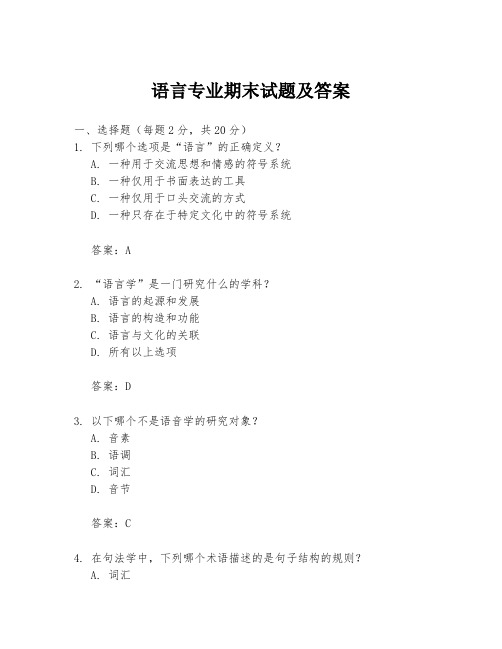
语言专业期末试题及答案一、选择题(每题2分,共20分)1. 下列哪个选项是“语言”的正确定义?A. 一种用于交流思想和情感的符号系统B. 一种仅用于书面表达的工具C. 一种仅用于口头交流的方式D. 一种只存在于特定文化中的符号系统答案:A2. “语言学”是一门研究什么的学科?A. 语言的起源和发展B. 语言的构造和功能C. 语言与文化的关联D. 所有以上选项答案:D3. 以下哪个不是语音学的研究对象?A. 音素B. 语调C. 词汇D. 音节答案:C4. 在句法学中,下列哪个术语描述的是句子结构的规则?A. 词汇B. 语法C. 语义D. 语音答案:B5. 语用学主要研究的是:A. 语言的发音规则B. 语言的书写规则C. 语言的使用和语境D. 语言的词汇量答案:C6. 以下哪个选项是“方言”的正确定义?A. 一种特定的语言B. 一种语言的变体C. 一种语言的书面形式D. 一种语言的口头形式答案:B7. 语言的“借词”通常指的是:A. 从其他语言借用的词汇B. 从其他语言借用的语法结构C. 从其他语言借用的发音规则D. 从其他语言借用的书写系统答案:A8. 以下哪个选项是“双语”的正确定义?A. 能够同时使用两种语言B. 能够阅读两种语言C. 能够书写两种语言D. 能够理解两种语言答案:A9. 以下哪个是“翻译”的正确定义?A. 将一种语言的文本转换为另一种语言B. 将一种语言的语音转换为另一种语言C. 将一种语言的书写转换为另一种语言的语音D. 所有以上选项答案:D10. “语码转换”是指:A. 在不同语言之间切换B. 在不同方言之间切换C. 在不同语境中使用不同的语言形式D. 在不同文化中使用相同的语言形式答案:C二、填空题(每空2分,共20分)11. 语言是一种_______,它包括语音、语法、语义和语用四个层面。
答案:符号系统12. 语言学的分支包括语音学、语法学、语义学、语用学和_______。
语言学期末考试题及答案
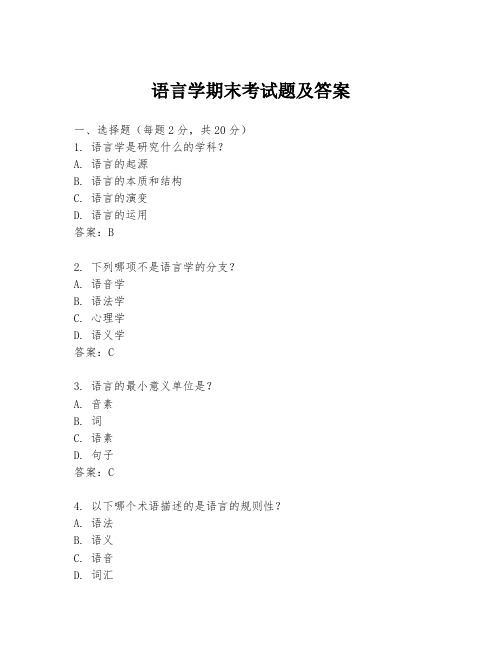
语言学期末考试题及答案一、选择题(每题2分,共20分)1. 语言学是研究什么的学科?A. 语言的起源B. 语言的本质和结构C. 语言的演变D. 语言的运用答案:B2. 下列哪项不是语言学的分支?A. 语音学B. 语法学C. 心理学D. 语义学答案:C3. 语言的最小意义单位是?A. 音素B. 词C. 语素D. 句子答案:C4. 以下哪个术语描述的是语言的规则性?A. 语法B. 语义C. 语音D. 词汇5. 语言的交际功能指的是什么?A. 语言的内部结构B. 语言的外部形式C. 语言的社会功能D. 语言的个人表达答案:C6. 语言的哪一部分负责表达概念?A. 语音B. 语法C. 语义D. 词汇答案:C7. 下列哪项是语言的物理表现形式?A. 语法B. 语义C. 语音D. 语用答案:C8. 语言的哪一部分负责表达关系?A. 语法B. 语义C. 语音D. 词汇答案:A9. 语言的哪一部分负责表达情感?B. 语用C. 语音D. 词汇答案:B10. 以下哪个术语描述的是语言的变异?A. 语言变异B. 语言变化C. 语言演化D. 语言发展答案:A二、填空题(每空1分,共20分)1. 语言学的主要研究对象是______。
答案:语言2. 语言的三个基本功能包括表达、______和交际。
答案:指称3. 语音学研究的是语言的______方面。
答案:声音4. 语法学研究的是语言的______方面。
答案:结构5. 语义学研究的是语言的______方面。
答案:意义6. 词汇学研究的是语言的______方面。
答案:词汇7. 语用学研究的是语言的______方面。
答案:使用8. 语言的最小意义单位是______。
答案:语素9. 语言的最小声音单位是______。
答案:音素10. 语言的最小结构单位是______。
答案:词三、简答题(每题10分,共40分)1. 请简述语言学的主要研究内容。
答案:语言学主要研究语言的本质、结构、发展、变化以及语言在社会和个人中的作用。
语言学期末试题及答案
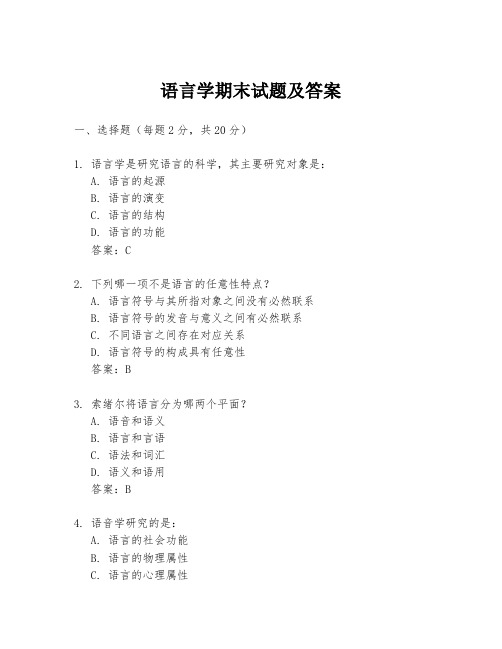
语言学期末试题及答案一、选择题(每题2分,共20分)1. 语言学是研究语言的科学,其主要研究对象是:A. 语言的起源B. 语言的演变C. 语言的结构D. 语言的功能答案:C2. 下列哪一项不是语言的任意性特点?A. 语言符号与其所指对象之间没有必然联系B. 语言符号的发音与意义之间有必然联系C. 不同语言之间存在对应关系D. 语言符号的构成具有任意性答案:B3. 索绪尔将语言分为哪两个平面?A. 语音和语义B. 语言和言语C. 语法和词汇D. 语义和语用答案:B4. 语音学研究的是:A. 语言的社会功能B. 语言的物理属性C. 语言的心理属性D. 语言的语法结构答案:B5. 下列哪一项不属于词汇语义学的研究范畴?A. 同义关系B. 反义关系C. 句法结构D. 词义变化答案:C6. 语言的最小意义单位是:A. 音位B. 词C. 词素D. 语素答案:C7. 语言的组合规则属于:A. 语音学B. 词汇学C. 句法学D. 语用学答案:C8. 语言的聚合规则属于:A. 语音学B. 词汇学C. 句法学D. 语用学答案:B9. 下列哪一项是社会语言学的研究内容?A. 语言的起源B. 语言的演变C. 语言的社会功能D. 语言的语法结构答案:C10. 语言的变异性体现在:A. 语音的变化B. 语法的变化C. 词汇的变化D. 所有选项答案:D二、填空题(每空1分,共10分)1. 语言学的分支学科包括语音学、语法学、__________、语用学等。
答案:词汇学2. 语言的两种基本功能是表达和__________。
答案:交流3. 索绪尔认为语言符号是由__________和所指构成的。
答案:能指4. 语言的音位变体称为__________。
答案:音位变体5. 语言的最小语音单位是__________。
答案:音素6. 语言的最小语法单位是__________。
答案:词7. 语言的最小语义单位是__________。
答案:语义素8. 语言的__________是指语言随时间的演变。
语言学考试试题及答案
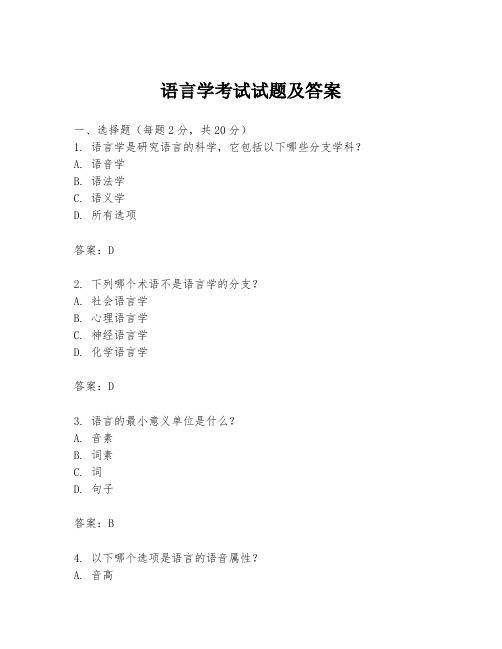
语言学考试试题及答案一、选择题(每题2分,共20分)1. 语言学是研究语言的科学,它包括以下哪些分支学科?A. 语音学B. 语法学C. 语义学D. 所有选项答案:D2. 下列哪个术语不是语言学的分支?A. 社会语言学B. 心理语言学C. 神经语言学D. 化学语言学答案:D3. 语言的最小意义单位是什么?A. 音素B. 词素C. 词D. 句子答案:B4. 以下哪个选项是语言的语音属性?A. 音高B. 音长C. 音色D. 所有选项答案:D5. 语言的语法规则可以是:A. 显性的B. 隐性的C. 两者都是D. 两者都不是答案:C6. 以下哪种语言现象不属于语言变异?A. 方言B. 社会方言C. 语言接触D. 语言消亡答案:D7. 语言的演变通常被认为是:A. 随机的B. 有目的的C. 无意识的D. 有意识的答案:C8. 语言接触可能导致:A. 语言融合B. 语言分离C. 语言借用D. 所有选项答案:D9. 语言的语用学研究的是:A. 语言的语境B. 语言的功能C. 语言的意义D. 所有选项答案:D10. 以下哪个术语不属于语义学研究的范围?A. 语义场B. 语义角色C. 语义关系D. 音位学答案:D二、填空题(每题2分,共20分)1. 语言的______属性包括音高、音长和音色。
答案:语音2. 语言的______属性包括语法、词汇和语义。
答案:结构3. 语言的______属性涉及语言的社会和文化方面。
答案:社会4. 语言学中的______理论认为语言是一系列规则的集合。
答案:形式主义5. 语言的______是语言学研究的基础单位。
答案:句子6. 语言的______是指语言在不同社会群体中的变体。
答案:变异7. 语言的______是指语言在不同地理区域的变体。
答案:方言8. 语言的______是指语言在不同时间的演变。
答案:历史9. 语言的______是指语言在不同语境中的使用。
答案:语用10. 语言的______是指语言的抽象意义。
语言学期末考试试题
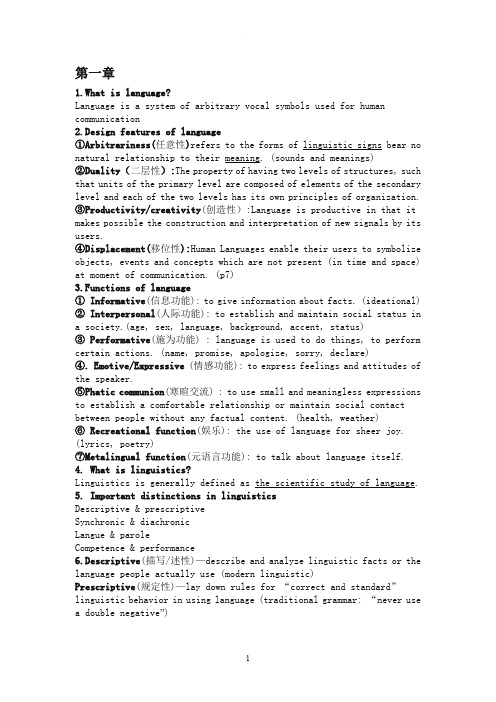
第一章1.What is language?Language is a system of arbitrary vocal symbols used for human communication2.Design features of language①Arbitrariness(任意性)refers to the forms of linguistic signs bear no natural relationship to their meaning. (sounds and meanings)②Duality(二层性):The property of having two levels of structures, such that units of the primary level are composed of elements of the secondary level and each of the two levels has its own principles of organization.③Productivity/creativity(创造性):Language is productive in that it makes possible the construction and interpretation of new signals by its users.④Displacement(移位性):Human Languages enable their users to symbolize objects, events and concepts which are not present (in time and space) at moment of communication. (p7)3.Functions of language① Informative(信息功能): to give information about facts. (ideational)② Interpersonal(人际功能): to establish and maintain social status ina society.(age, sex, language, background, accent, status)③ Performative(施为功能) : language is used to do things, to perform certain actions. (name, promise, apologize, sorry, declare)④. Emotive/Expressive (情感功能): to express feelings and attitudes of the speaker.⑤Phatic communion(寒暄交流) : to use small and meaningless expressions to establish a comfortable relationship or maintain social contact between people without any factual content. (health, weather)⑥ Recreational function(娱乐): the use of language for sheer joy. (lyrics, poetry)⑦Metalingual function(元语言功能): to talk about language itself.4. What is linguistics?Linguistics is generally defined as the scientific study of language.5. Important distinctions in linguisticsDescriptive & prescriptiveSynchronic & diachronicLangue & paroleCompetence & performance6.Descriptive(描写/述性)—describe and analyze linguistic facts or the language people actually use (modern linguistic)Prescriptive(规定性)—lay down rules for “correct and standard”linguistic behavior in using language (traditional grammar: “never use a double negative”)7.Synchronic study (共时)—description of a language at some point of time (modern linguistics)Diachronic study (历时)— description of a language as it changes through time (historical development of language over a period of time)第四章1.What is Syntax (句法)?Syntax is the study of the rules governing the ways different constituents are combined to form sentences.句法就是研究语言的不同成分组成句子的规则2.Four Approaches :The traditional approach传统语言观(Parts of speech、Syntactic Function不考、Category范畴、Concord and government一致关系和支配关系)、The structural approach结构语言观、The generative approach、The functional approach功能语言观3.The traditional grammar regards sentences as a sequence of words , so it pays great attention to the study of words , such as the classification of words in terms of parts of speech , the identification of function of words in terms of subject, predicate , etc.4. Parts of speechTraditional grammar defines 8 parts of speech: nouns, verbs, pronouns, adjectives, adverbs, prepositions, conjunctions and interjections. 5.The term Category范畴 in some approaches refers to word classes and functions in its narrow sense,范畴这一术语狭义上是指词类和功能 eg. Noun, Verb, Subject, Predicate. More specifically, it refers to the defining properties of these general units:the categories of the noun名词的范畴, include number, gender, case and countability(case);the categories of the verb动词的范畴: tense, aspect, voice, etc. 6.Number is mostly a category of the noun and pronoun名词和不可数名词.Two terms of number in nouns: singular and plural单数和复数Number is also reflected in the inflections of pronouns and verbs7. Gender is also mostly a category of the noun and pronoun.In English, the gender distinctions are on the whole natural, determined by the biological gender of the creature.8. Case is used in the analysis of word classes to identify the syntactic relationship between words in a sentence.在词类分析中,格范畴用来辨别句子中词之间的句法关系In English, pronouns have three cases of nominative主格, accusative受格, and genitive与格. Nouns have two of general and genitive所有格In English, the case of noun is realised in three channels:(a) inflection(b) following a preposition(c) word order9. Tense时态: the absolute location of an event or action on time. It is marked by an inflection of the verb. As a result, there are only two tenses recognized now: past and present.Since the future time does not involve any inflection of the verb, we do not refer to a “future tense”, even though in many different ways we can talk about the future.10. Aspect体: It has nothing with time, and it tells us whether an action is ongoing or completed.Perfective(完成体) and Imperfective(进行体)Perfective and Progressive (in English)11. Voice语态: describe the relationship between verb and subject Passive被动语态 and active主动语态12. Concord and government①Concord (一致关系) refers to agreement between words, especially between a verb and the subject of a sentence.②Government (支配关系)is a type of grammatical relationship between two or more elements in a sentence.In traditional grammar, the term government has typically been used to refer to the relationship between verbs and nouns or between prepositions and nouns.13.The Structural Approach ,由Ferdinand de Saussure提出14.Syntactic Relations:Positional relations位置关系、Relations of substitutability替代关系、Relations of co-occurrence同现关系15.Immediate constituent (直接成分)is any meaningful constituent at the first step in an analysis.16.An endocentric construction(向心结构) is a construction that contains:1) a head, which is the single obligatory element in the construction;2) one or more optional elements subordinate to the head.17.them e(主位) refers to the known information which is not new to the reader or listenerRheme (述位) refers to the information that is new. The new information is what is to be transmitted to the reader or listenerThe linguists of the Prague school believed that sentence may be analyzed from the functional side as well as the grammatical side.subject, predicate (grammatical side)theme, rheme (functional side)第五章1. What is Semantics?Semantics is the study of the meaning of words, phrases and sentences.语义学是研究单词、短语和句子的意义的学科2.Geoffrey Leech利奇Seven types of meaning7种意义类型:①Conceptual meaning概念意义②Connotative meaning内涵意义③Social meaning社会意义④Affective meaning 感情意义Associative Meaning联想意义(②——⑥)⑤Reflected meaning反射意义⑥Collocative meaning搭配意义⑦Thematic meaning主位意义3.Conceptual meaning(概念意义) is also called “denotative”(外延义)and it is concerned with the relationship between a word and the thing it refers to.概念意义也叫外延义,它关注词语跟它所指称事物之间的联系Conceptual meaning is meaning given in the dictionary.4.Associative meaning(联想意义)is the total of all the meanings a person thinks of when they hear the wordAssociative meaning is the meaning which a word suggests or implies.5.Thematic meaning (主位意义) is “what is communicated by the way in which the message is organized in terms of order and emphasis.”它是由词序和词语重音所决定的6. The Referential Theory(指称理论):① The Referential Theory② The Semantic Triangle③ Sense and Reference7.The referential theory指称理论 is the theory of meaning which relates the meaning of a word to the thing it refers to.指称论是把词语意义跟它所指称的事物联系起来的理论8. The semantic triangle语意三角 is the indirect relation between a word and a thing it refers to and it is mediated by concept.语意三角指词和所指事物之间没有直接关系,它们是以概念为中介的9.Sense (涵义) is a set of properties possessed by a name.10.Reference (指称) is the symbolic relationship that a linguistic expression has with the concrete object.11. The sense of an expression is the thought it expresses, while its reference is the object it representsEvery word has a sense, but not every word has a reference.12. Sense Relations涵义关系①Synonymy(同义关系)②Antonymy(反义关系)(Gradable、Complementary、Converse)③Hyponymy(上下义关系)13.But total synonymy is rare. They may differ in style, connotations and dialect.14.Gradable antonymy (等级反义关系) 、Complementary antonymy (互补反义关系)、Converse antonymy (反向反义关系)15. Componential analysis is an approach to the study of meaning which analyses a word into a set of meaning components.16. Sentence Meaning17. Sense relations between sentences① Synonymity (同义)a. He was a bachelor all his life.b. He never married all his boy.Sentences a and b are in a synonymous relationship: the truth of one sentence necessarily implies the truth of another sentence②Inconsistency(矛盾)a. Elizabeth II is Queen of England.b. Elizabeth II is a man.Sentences a and b are in a relationship of contradiction: the truth of one sentence necessarily implies the falseness of another sentence.③Entailment (蕴涵)a. He married a blonde heiress.b. He married a blonde.Entailment refers to a kind of meaning inclusion. If x entails y, the meaning of x is included in y.④Presupposition(前提预设)It is what a speaker or writer assumes that the receiver of the message already knows.⑤Contradiction(矛盾)⑥Semantic anomaly(语义反常)18. An integrated theory﹡Compositionality(组合性原则):the meaning of a sentence depends on the meaning of the constituent words and the way they are combined.﹡This semantic theory is the integration of syntax and semantics﹡Their basic idea is that a semantic theory consists of two parts: a dictionary and a set of projection rules﹡The dictionary provides the grammatical classification and semantic information of words﹡The projection rules are responsible for combining the meanings of words together.19.Logical semantics(逻辑语义学)﹡A proposition(命题) is what is to be expressed by a declarative sentence when that sentence is uttered to make a statement.﹡It is the basic meaning which a sentence express.﹡A very important property of the proposition is that it has a truth value.第七章nguage and Culture:①Sapir-Whorf Hypothesis②Evidence Given by Whorf③Implication of SWH ④Relation between Language and Culture2.SHW can be broken down into two basic principles:Linguistic determinism (语言决定论): the language we use determines the way we view about the world around us.Language may determine our thinking patterns. (语言决定思维) P1623. Relation between Language and CultureLanguage influences thought and culture,Language varies in categories and concepts, thus reflecting the different world views of different language users, that is, culture and thought are conditioned by language Culture influences language,Every language is a part of a culture. As such, it can not but serve and reflect cultural needs. When a culture experience radical changes, the vocabulary also undergoes corresponding alterationsnguage and SocietyRelation between Language and SocietyVarieties of language(Dialects、Registers)Bilingualism and DiglossiaPidgin and Creole5.Varieties related to the user are normally known as dialects and varieties related to use as registers.6.Dialectal Varieties :Regional dialect、Social dialect(Sociolect、Language and gender、 Language and age、 Idiolect、 Ethnic dialect)7.Social dialect refers to a variety of language associated with a particular social group, such as a particular social class, or ethnic group, or those based on age, gender and occupation.8.An ethnic dialect is a social dialect of a language that cuts across regional differences; it is mainly spoken by a less privileged population that has experienced some form of social isolation such as racial discrimination or segregation.9.Idiolect refers to the speech variety of an individual. Every speaker has his own way of expressing his or her idea.10.Register refers to the functional variety of language that is defined according to its use in a context of situation.11.Halliday’s Register TheoryLanguage varies as its function varies; it differs in different situations.Halliday distinguishes 3 variables that determine the register:field of discourse (语场)、 tenor of discourse (语旨)、 mode of discourse (语式) 12.Bilingualism (双语制): the use of two languages, esp with equal or nearly equal fluency.13.Diglossia (双语体现象): when two varieties of a language exist side by side; and each is used for different purposes, this is called diglossia. 14.A pidgin : it is a special language variety that mixes and blends languages used for communicative purposes by groups of people who do not know each other’s language.15.A creole : when a pidgin has become the primary language of a speech community, and is acquired by the children of that speech community as their native language, it is said to have become a creole.第八章1.What is PragmaticsPragmatics is the study of language in context / use / communication.2 Semantics and PragmaticsSimilarity:Pragmatics and semantics are both linguistic study of meaning Difference:Semantic meaning: the more constant, inherent side of meaning ;Pragmatic meaning: the more indeterminate, the more closely related to context ;Pragmatic = meaning - semantics3.Three Contents :Speech Act Theory、The Theory of Conversational Implicature、Post-Gricean Developments4.Speech Act Theory(言语行为理论):① Performatives and Constatives②A theory of the illocutionary act5.The utterance which performs an act is called a performative(行事话语)。
语言学期末题及参考答案
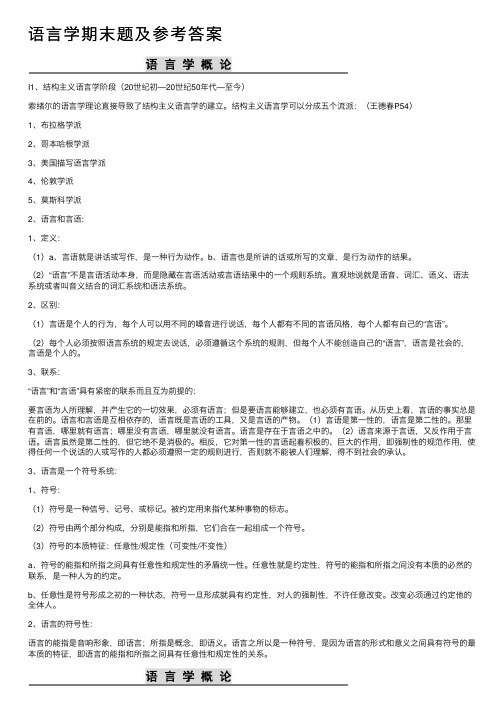
语⾔学期末题及参考答案I1、结构主义语⾔学阶段(20世纪初—20世纪50年代—⾄今)索绪尔的语⾔学理论直接导致了结构主义语⾔学的建⽴。
结构主义语⾔学可以分成五个流派:(王德春P54)1、布拉格学派2、哥本哈根学派3、美国描写语⾔学派4、伦敦学派5、莫斯科学派2、语⾔和⾔语:1、定义:(1)a、⾔语就是讲话或写作,是⼀种⾏为动作。
b、语⾔也是所讲的话或所写的⽂章,是⾏为动作的结果。
(2)“语⾔”不是⾔语活动本⾝,⽽是隐藏在⾔语活动或⾔语结果中的⼀个规则系统。
直观地说就是语⾳、词汇、语义、语法系统或者叫⾳义结合的词汇系统和语法系统。
2、区别:(1)⾔语是个⼈的⾏为,每个⼈可以⽤不同的嗓⾳进⾏说话,每个⼈都有不同的⾔语风格,每个⼈都有⾃⼰的“⾔语”。
(2)每个⼈必须按照语⾔系统的规定去说话,必须遵循这个系统的规则,但每个⼈不能创造⾃⼰的“语⾔”,语⾔是社会的,⾔语是个⼈的。
3、联系:“语⾔”和“⾔语”具有紧密的联系⽽且互为前提的:要⾔语为⼈所理解,并产⽣它的⼀切效果,必须有语⾔;但是要语⾔能够建⽴,也必须有⾔语。
从历史上看,⾔语的事实总是在前的。
语⾔和⾔语是互相依存的,语⾔既是⾔语的⼯具,⼜是⾔语的产物。
(1)⾔语是第⼀性的,语⾔是第⼆性的。
那⾥有⾔语,哪⾥就有语⾔;哪⾥没有⾔语,哪⾥就没有语⾔。
语⾔是存在于⾔语之中的。
(2)语⾔来源于⾔语,⼜反作⽤于⾔语。
语⾔虽然是第⼆性的,但它绝不是消极的。
相反,它对第⼀性的⾔语起着积极的、巨⼤的作⽤,即强制性的规范作⽤,使得任何⼀个说话的⼈或写作的⼈都必须遵照⼀定的规则进⾏,否则就不能被⼈们理解,得不到社会的承认。
3、语⾔是⼀个符号系统:1、符号:(1)符号是⼀种信号、记号、或标记。
被约定⽤来指代某种事物的标志。
(2)符号由两个部分构成,分别是能指和所指,它们合在⼀起组成⼀个符号。
(3)符号的本质特征:任意性/规定性(可变性/不变性)a、符号的能指和所指之间具有任意性和规定性的⽭盾统⼀性。
语言学-期末考试-复习材料

语言学-期末考试-复习材料一、选择(20个)二、判断(10~20个)三、填空(5分)四、词语解释(3个,各5分)五、简答(2个,各10分;其中一个是语用学)六、句子分析(4个)IC analysis 是倒着的树形图Chomsky 是有S, NP,VP…与其中的树形图。
1. Phonetics & Language Introduction:1. There is no logical connection between meaning and sounds. A dog might be a pig if only the first person or group of persons had used it for a pig. This is __B____one of the design features of language.A. dualityB. arbitrarinessC. productivityD. displacement2. Language is a system of two sets of structures, one of sounds and the other of meaning. This is __B__ . It makes people possible to talk everything within his knowledge.A. dualityB. arbitrarinessC. productivityD. displacement3. __C___ refers to the ability to construct and understand an indefinitely large number of sentences in one?s native language, including those that he has never heard before, but that are appropriate to the speaking situation.A. dualityB. arbitrarinessC. productivityD. displacement4. ___D__ refers to the fact that one can talk about things that are not present, as easily as he does things present. The dog couldn?t be bow-wowing sorrowfully for some lost love or a bone to be lost.A. dualityB. arbitrarinessC. productivityD. displacement5. ___D___ means language is not biologically transmitted from generation to generation, but the linguistic system must be learnt anew by each speaker.A. dualityB. ArbitrarinessC. interchangeabilityD. cultural transmission6. ___C___ means that any human being can be both a producer and a receiver of messages.A. dualityB. ArbitrarinessC. interchangeabilityD. cultural transmission7. To say “How are you. ”“Hi”to your friends is the ___C____of language.A. directive functionB. informative functionC. phatic function (adj. 交流感情/交际应酬的)D. interrogative function8. “Tell me the result when you finish.”If you want to get your hearer to do something, you should use the ___B__ function of language.A. directive functionB. informative functionC. phatic functionD. interrogative function9. A linguist regards the changes in language and language use as _____.A. unnaturalB. something to be fearedC. natural C. abnormal10. A linguist is interested in _______.A. speech sounds onlyB. all soundsC. vowels only C. consonants only11. Which of the following sounds is a voiceless bilabial stop?A. [t]B. [m]C. [b]D. [p]12. Which of the following sounds is a voiced affricate?A. [y]B. [t∫]C. [z]D. [dЗ]13. Which of the following sounds is a central vowel?A. [ ? ]B. [ i ]D. [a: ]14. In the following sounds , ______ is a palatal fricative ?A. [ s ]B. [∫]C. [ l ]D. [θ]15. In the following sounds , ______ is a voiceless affricative ?A. [dЗ]B. [ v ]C. [t∫]D. [θ]16. In English if a word begins with a [ l ] or [ r ],then the next sound must be a ____.A. fricativeB. nasal soundC. semi-vowelD. vowel17. Of the “words”listed below, _____ is not an English word ?A. [r∧b ]B. [ l? b ]C. [m?sta:∫]D. [lm?p]18. _____ are produced when the obstruction created by the speech organs is total and audibly released.A. Back vowelsB. StopsC. Fricatives C. Glides19. The International Phonetic Association devised the INTERNATIONAL PHONETIC ALPHABET in ______.B. 1957C. 1888D. 178820. ____ is a phonological unit , and it is a unit that is of distinctive value.A. PhoneB. PhonemeC. AllophoneD. SoundII. Tell which statements are true or false.1. [ f ] is a dental consonant.2. Phonology studies the characteristics of speech sounds and provides methodsfor their description, classification and transcription.3. Phoneme is a phonological unit.4. Phone is a phonetic unit.5. When we study the different [ p ]’s in “[ pit ], [tip ], [spit ]”, they are similarphones which belong to phonetics.6. But the three [ p ] belong to the different phoneme / p /.7. The three / p / are allophones.8. ‘peak’is aspirated , phonetically transcribed as [ph]; ‘speak’isunaspirated (不送气的)phonetically[ p=].9. [ph ], [p=] do not belong to the same phoneme / p /.10. [p h] and [ p=] are two different phones, and are variants of the phoneme / p /,which is called ALLOPHONES of the same phoneme.key: BACDD CCACA DDABC DDBCB FFTTT FTTFTI. Choose the best choice(语音)1. Which is a voiced bilabial stop?A. [m]B. [v]C. [p]D. [b]2. Which is a voiceless affricate?A. [w]B. [f]C. [t∫]D. [n]3. Which is monophothong?A. [i]B. [au]C. [ai]D. [ei]4. Which is a voiceless bilabial stop?A. [p]B. [m]C. [b]D. [t]5. Which is a voiced affricate?A. [j]B. [z]C. [t∫]D. [dЗ]6. Which is a central vowel ?A. [i]B. [?:]C. [ou]D. [a:]7. In English if a word begins with [l] or [r] , then the next sound must be a ____.A. fricativeB. nasal soundC. semi-vowelD. vowel8. Which is a palatal fricative?A. [s]B. [k]C. [∫]D. [l]9. Which is not a English word?A. [r ?b]B. [l?b]C. [sta:∫]D. [ lm?p]10. Which is a unaspirate?A. skyB. killC. likeD. kite2. Semantics 练习1._______ is not included in Leech?s associative meaning.A. Connotative meaningB. Social meaningC. Collocative meaningD. Thematic meaning2. Among Leech?s seven types of meaning is concerned with the relationship betweena word and the thing it refers to _______.A. conceptualB. affectiveC. reflectedD. thematic3. According to the referential theory, a word is not directly related to the thing it refers to. They are connected by ______.A. meaningB. referenceC. conceptD. sense4.”Big” and “Small” are a pair of ______ opposites.A. complementaryB. gradableC. completeD. Converse5. The pair of words “lend” and “borrow” are ______.A. gradable opposites B, converse opposites C. co-hyponymsD. synonyms6. A word with several meaning is called ______ word.A. a polysemousB. a synonymousC. an abnormalD. a multiple7. The semantic compone nts of the word “gentleman” can be expressed as ___.A. +animate, +male, +human, -adultB. +animate, +male, +human, +adultA. +animate, -male, +human, -adult D. + animate, -male, +human, +adult8. _____ is a phrase which can only be understood as a unit, not as a summation of themeaning of each constituent word.A. CollocationB. IdiomC. Semantic componentD. Synonym9. In the triangle advanced by Ogden and Richards, “thought or reference” is____A. word, sentenceB. the objectC. conceptD. symbol10. A linguistic is interested in _____.A. What is said.B. What is right both in syntax and in semantics.C. What is grammaticalD. What ought to be said.11. The pair of words “lend” and “borrow” are _____.A. gradable oppositesB. relational oppositesC. synonymsD. co-hyponyms12. Nouns, verbs, and adjectives can be classified as _____.A. Lexical wordsB. grammatical wordsC. function wordsD. form words13. What is t he meaning relationship between the two words “flower/tulip” ?A. PolysemyB. HomonymyC. HyponymyD. Antonymy14. The words “railway” and “railroad” are _____.A. synonyms differing in emotive meaningB. dialectal synonymsC. collocationally-restricted synonymsD. synomyms differing in styles15. The pair of words “wide/narrow” are called____.A. gradable oppositesB. complementary antonymsC. co-hyponymsD. relational opposites16. Which of the following two-term sets shows the feature of complementaries?A. single/marriesB. lend/borrowC. hot/coldD. old/youngDACBB _BBBB BACBA AII. Answer the questions with “Yes”or “No” .1.Is reference tied to a particular time and place? Y2.Every word in a language can find at least one referent in the objective world. ?N3.Can different expressions have the same referent? Y4.Can reference be applied to words such as “and” ,”very” in English? NIII.State the following sentences “True” or “False”.1. Sense is regarded as a kind of intra-linguistic relationship. T2. In most cases, “sense” and “meaning” are different terms for the same thing. T3. Every word has its own sense. F4. A word may have several different senses and several words may have the samesense. T5. Extension, like denotation, is a kind of relation between elements and theobjective world. T6. Extension can only be applied to the things at present. F7. The relation between extension and intension is the same as that betweendenotation and sense. T8. People of different cultures may choose different prototype for the same predicate,e.g. …bus?. T9. All the words in a language can be used to refer , but only some have sense. F10. Two synonymous words must be identical in sense in every dimension. F11. There are very few perfect synonyms in a language. T12. Entailment is more inclusive than paraphrase. T13. Almost every word in a dictionary is polysemic. T14. Dry and wet are a pair of gradable antonyms. T15. Innocent and guilt are a pair of relative antonyms. F Complementary16. The relationship between the Argument and Predicate is Subject to predicate.F17. The meaning of each expression can be defined in terms of its semanticcomponents so as to contrast with the meaning of all the expressions in the same language. T18. The proposition of a sentence may be more simply stated as a verb and a selection of case ---categories. T19. According to case grammar, the part of proposition in a sentence is a tensed set of relationships between a verb and a noun phrase ( or noun phrases).4. Exercises to Chapter 4 SyntaxI. General view of syntax1. Syntax: studies the rules governing the way words are combined to form sentences.2. gender: as masculine, feminine, neuter, or animate, and inanimate.3. case: the syntaxtic relationship between words. Teacher?s , kiss him宾格,主格,与格,芬兰语有15种格4.Concord: agreement: a syntactic relationship agree with each other.5. Government : A word determines the form of others.支配关系6. langue and paroleLangue: abstract linguistic system shared by all the members of a speechcommunity. StabilityParole: actual speech7. signified (concept) and signifier (sound image)1. 所指 2 能指之间的关系是任意的8. syntagmatic and paradigmatic relationsSyntagmatic: what precedes or follows9. synchronic and diachronic linguistics10. “Rheme” “Theme”负载交际能力最小的是主位。
语言专业期末试题及答案

语言专业期末试题及答案一、选择题(每题2分,共20分)1. 以下哪个选项是“语言”的英文翻译?A. LiteratureB. LanguageC. CultureD. History答案:B2. “语言学”是一门研究什么的学科?A. 语言的历史B. 语言的起源C. 语言的结构D. 语言的使用答案:C3. 以下哪个选项是“语法”的正确定义?A. 语言的发音规则B. 语言的书写规则C. 语言的词汇规则D. 语言的句法规则答案:D4. 语言的“词汇”指的是什么?A. 语言的音韵系统B. 语言的语法系统C. 语言的语音系统D. 语言的词和短语5. 以下哪种语言属于罗曼语族?A. 英语B. 德语C. 法语D. 俄语答案:C6. “语音学”研究的是语言的哪个方面?A. 语言的词汇B. 语言的语法C. 语言的发音D. 语言的书写答案:C7. 以下哪个选项是“语义学”的正确定义?A. 研究语言的发音B. 研究语言的意义C. 研究语言的语法D. 研究语言的历史答案:B8. “修辞学”主要研究什么?A. 语言的发音B. 语言的书写C. 语言的表达方式D. 语言的词汇答案:C9. “社会语言学”关注的是语言与哪种因素的关系?B. 社会C. 经济D. 技术答案:B10. “心理语言学”主要研究的是?A. 语言与社会的关系B. 语言与心理的关系C. 语言与文化的关系D. 语言与经济的关系答案:B二、填空题(每空1分,共10分)1. 语言的三大基本要素是语音、________和语法。
答案:词汇2. 语言的________是指语言的发音规则。
答案:音韵学3. 在语言学中,________是指语言的最小意义单位。
答案:语素4. 语言的________是指语言的词和短语的组合规则。
答案:句法5. 语言的________是指语言的意义规则。
答案:语义学6. 语言的________是指语言的使用规则。
答案:语用学7. 语言的________是指语言的书写规则。
语言学概论期末考试试卷5

语⾔学概论期末考试试卷5语⾔学概论期末考试试卷5题号⼀⼆三四五六总分得分⼀、填空题(每空1分,共15分)1、语⾔系统具有性和性。
2、⾳位是从的⾓度划分出来的语⾳单位,它是特定语⾔或⽅⾔中具有作⽤的最⼩的语⾳单位。
3、社会的地域分化会导致语⾔的,在⼀种语⾔的内部形成不同的或。
4、⼼理语⾔学的两个分⽀学科是指和,这两个学科也可以统称为。
5、通常说的⼈的认知活动主要是指的活动。
6、语⾔学在⼈⽂科学中的应⽤最重要的是跟和有关的直接应⽤研究,还可以包括语⾔学与、等学科的交叉研究。
⼆、单项选择题(每⼩题1分,共10分)1、⾔语是()A.⾔论和语⾔ B.⾳义结合的符号系统C.个⼈说的⾏为和结果 D.写成的作品或发表的⾔论2、语⾔学概论应属于()A.个别语⾔学 B.⼀般语⾔学 C.应⽤语⾔学 D.汉语⾔学3、元⾳[o]是()A.前半⾼圆唇⾆⾯元⾳ B.后半低圆唇⾆⾯元⾳C.后半⾼圆唇⾆⾯元⾳ D.后⾼不圆唇⾆⾯元⾳4、汉语普通话“⾟苦”[in k u]快读成[i k u]这种现象是()A.顺同化 B.顺异化 C.逆同化 D.逆异化5、“游泳”是⼀个()A.语素 B.句⼦ C.离合词 D.词组6、下⾯这些语法⼿段中,属于句法⼿段的是()A.词的轻重⾳ B.词的重叠 C.屈折 D.语调7、下⾯词组中属于偏正词组的是()A.看⼩说 B.悄悄进来 C.门开了 D.抬进去8、语⾔产⽣、存在和发展的基本条件是()A.⼈类发⾳器官的健全 B.⼈类⼼理的健全C.社会交际活动的需要 D.⼈类劳动的需要9、⼈的⼤脑的左半球的⼀定部位掌管语⾔和抽象的思维活动,这种现象称为()A.分区 B.单侧化 C.临界期 D.语⾔获得10、汉语中的“狗”和英语中的“dog”在意义褒贬上具有差异说明了()A.词义反映了不同民族的社会⼼理 B.语⾔和⽂化互不相关C.中英⽂化没有相通之处 D.不同民族思维不同三、名词解释(每⼩题4分,共16分)1、语义场2、地域⽅⾔3、语⾔信息处理4、语⾳的⽣理属性四、简答题(每⼩题7分,共21分)1、简要叙述语⾔的客观存在形式和⼈的主观认识的关系。
- 1、下载文档前请自行甄别文档内容的完整性,平台不提供额外的编辑、内容补充、找答案等附加服务。
- 2、"仅部分预览"的文档,不可在线预览部分如存在完整性等问题,可反馈申请退款(可完整预览的文档不适用该条件!)。
- 3、如文档侵犯您的权益,请联系客服反馈,我们会尽快为您处理(人工客服工作时间:9:00-18:30)。
第一章1.What is language?Language is a system of arbitrary vocal symbols used for human communication2.Design features of language①Arbitrariness(任意性)refers to the forms of linguistic signs bear no natural relationship to their meaning. (sounds and meanings)②Duality(二层性):The property of having two levels of structures, such that units of the primary level are composed of elements of the secondary level and each of the two levels has its own principles of organization.③Productivity/creativity(创造性):Language is productive in that it makes possible the construction and interpretation of new signals by its users.④Displacement(移位性):Human Languages enable their users to symbolize objects, events and concepts which are not present (in time and space) at moment of communication. (p7)3.Functions of language① Informative(信息功能): to give information about facts. (ideational)② Interpersonal(人际功能): to establish and maintain social status ina society.(age, sex, language, background, accent, status)③ Performative(施为功能) : language is used to do things, to perform certain actions. (name, promise, apologize, sorry, declare)④. Emotive/Expressive (情感功能): to express feelings and attitudes of the speaker.⑤Phatic communion(寒暄交流) : to use small and meaningless expressions to establish a comfortable relationship or maintain social contact between people without any factual content. (health, weather)⑥ Recreational function(娱乐): the use of language for sheer joy. (lyrics, poetry)⑦Metalingual function(元语言功能): to talk about language itself.4. What is linguistics?Linguistics is generally defined as the scientific study of language.5. Important distinctions in linguisticsDescriptive & prescriptiveSynchronic & diachronicLangue & paroleCompetence & performance6.Descriptive(描写/述性)—describe and analyze linguistic facts or the language people actually use (modern linguistic)Prescriptive(规定性)—lay down rules for “correct and standard”linguistic behavior in using language (traditional grammar: “never usea double negative”)7.Synchronic study (共时)—description of a language at some point of time (modern linguistics)Diachronic study (历时)— description of a language as it changes through time (historical development of language over a period of time)第四章1.What is Syntax (句法)?Syntax is the study of the rules governing the ways different constituents are combined to form sentences.句法就是研究语言的不同成分组成句子的规则2.Four Approaches :The traditional approach传统语言观(Parts of speech、Syntactic Function不考、Category范畴、Concord and government一致关系和支配关系)、The structural approach结构语言观、The generative approach、The functional approach功能语言观3.The traditional grammar regards sentences as a sequence of words , so it pays great attention to the study of words , such as the classification of words in terms of parts of speech , the identification of function of words in terms of subject, predicate , etc.4. Parts of speechTraditional grammar defines 8 parts of speech: nouns, verbs, pronouns, adjectives, adverbs, prepositions, conjunctions and interjections. 5.The term Category范畴 in some approaches refers to word classes and functions in its narrow sense,范畴这一术语狭义上是指词类和功能 eg. Noun, Verb, Subject, Predicate. More specifically, it refers to the defining properties of these general units:the categories of the noun名词的范畴, include number, gender, case and countability(case);the categories of the verb动词的范畴: tense, aspect, voice, etc. 6.Number is mostly a category of the noun and pronoun名词和不可数名词.Two terms of number in nouns: singular and plural单数和复数Number is also reflected in the inflections of pronouns and verbs7. Gender is also mostly a category of the noun and pronoun.In English, the gender distinctions are on the whole natural, determined by the biological gender of the creature.8. Case is used in the analysis of word classes to identify the syntactic relationship between words in a sentence.在词类分析中,格范畴用来辨别句子中词之间的句法关系In English, pronouns have three cases of nominative主格, accusative受格, and genitive与格. Nouns have two of general and genitive所有格In English, the case of noun is realised in three channels:(a) inflection(b) following a preposition(c) word order9. Tense时态: the absolute location of an event or action on time. It is marked by an inflection of the verb. As a result, there are only two tenses recognized now: past and present.Since the future time does not involve any inflection of the verb, we do not refer to a “future tense”, even though in many different ways we can talk about the future.10. Aspect体: It has nothing with time, and it tells us whether an action is ongoing or completed.Perfective(完成体) and Imperfective(进行体)Perfective and Progressive (in English)11. Voice语态: describe the relationship between verb and subject Passive被动语态 and active主动语态12. Concord and government①Concord (一致关系) refers to agreement between words, especially between a verb and the subject of a sentence.②Government (支配关系)is a type of grammatical relationship between two or more elements in a sentence.In traditional grammar, the term government has typically been used to refer to the relationship between verbs and nouns or between prepositions and nouns.13.The Structural Approach ,由Ferdinand de Saussure提出14.Syntactic Relations:Positional relations位置关系、Relations of substitutability替代关系、Relations of co-occurrence同现关系15.Immediate constituent (直接成分)is any meaningful constituent at the first step in an analysis.16.An endocentric construction(向心结构) is a construction that contains:1) a head, which is the single obligatory element in the construction;2) one or more optional elements subordinate to the head.17.them e(主位) refers to the known information which is not new to the reader or listenerRheme (述位) refers to the information that is new. The new information is what is to be transmitted to the reader or listenerThe linguists of the Prague school believed that sentence may be analyzed from the functional side as well as the grammatical side.subject, predicate (grammatical side)theme, rheme (functional side)第五章1. What is Semantics?Semantics is the study of the meaning of words, phrases and sentences.语义学是研究单词、短语和句子的意义的学科2.Geoffrey Leech利奇Seven types of meaning7种意义类型:①Conceptual meaning概念意义②Connotative meaning内涵意义③Social meaning社会意义④Affective meaning 感情意义Associative Meaning联想意义(②——⑥)⑤Reflected meaning反射意义⑥Collocative meaning搭配意义⑦Thematic meaning主位意义3.Conceptual meaning(概念意义)is also called “denotative”(外延义)and it is concerned with the relationship between a word and the thing it refers to.概念意义也叫外延义,它关注词语跟它所指称事物之间的联系Conceptual meaning is meaning given in the dictionary.4.Associative meaning(联想意义)is the total of all the meanings a person thinks of when they hear the wordAssociative meaning is the meaning which a word suggests or implies.5.Thematic meaning (主位意义) is “what is communicated by the way in which the message is organized in terms of order and emphasis.”它是由词序和词语重音所决定的6. The Referential Theory(指称理论):① The Referential Theory② The Semantic Triangle③ Sense and Reference7.The referential theory指称理论 is the theory of meaning which relates the meaning of a word to the thing it refers to.指称论是把词语意义跟它所指称的事物联系起来的理论8. The semantic triangle语意三角 is the indirect relation between a word and a thing it refers to and it is mediated by concept.语意三角指词和所指事物之间没有直接关系,它们是以概念为中介的9.Sense (涵义) is a set of properties possessed by a name.10.Reference (指称) is the symbolic relationship that a linguistic expression has with the concrete object.11. The sense of an expression is the thought it expresses, while its reference is the object it representsEvery word has a sense, but not every word has a reference.12. Sense Relations涵义关系①Synonymy(同义关系)②Antonymy(反义关系)(Gradable、Complementary、Converse)③Hyponymy(上下义关系)13.But total synonymy is rare. They may differ in style, connotations and dialect.14.Gradable antonymy (等级反义关系) 、Complementary antonymy (互补反义关系)、Converse antonymy (反向反义关系)15. Componential analysis is an approach to the study of meaning which analyses a word into a set of meaning components.16. Sentence Meaning17. Sense relations between sentences① Synonymity (同义)a. He was a bachelor all his life.b. He never married all his boy.Sentences a and b are in a synonymous relationship: the truth of one sentence necessarily implies the truth of another sentence②Inconsistency(矛盾)a. Elizabeth II is Queen of England.b. Elizabeth II is a man.Sentences a and b are in a relationship of contradiction: the truth of one sentence necessarily implies the falseness of another sentence.③Entailment (蕴涵)a. He married a blonde heiress.b. He married a blonde.Entailment refers to a kind of meaning inclusion. If x entails y, the meaning of x is included in y.④Presupposition(前提预设)It is what a speaker or writer assumes that the receiver of the message already knows.⑤Contradiction(矛盾)⑥Semantic anomaly(语义反常)18. An integrated theory﹡Compositionality(组合性原则):the meaning of a sentence depends on the meaning of the constituent words and the way they are combined.﹡This semantic theory is the integration of syntax and semantics﹡Their basic idea is that a semantic theory consists of two parts: a dictionary and a set of projection rules﹡The dictionary provides the grammatical classification and semantic information of words﹡The projection rules are responsible for combining the meanings of words together.19.Logical semantics(逻辑语义学)﹡A proposition(命题) is what is to be expressed by a declarative sentence when that sentence is uttered to make a statement.﹡It is the basic meaning which a sentence express.﹡A very important property of the proposition is that it has a truth value.第七章nguage and Culture:①Sapir-Whorf Hypothesis②Evidence Given by Whorf③Implication of SWH ④Relation between Language and Culture2.SHW can be broken down into two basic principles:Linguistic determinism (语言决定论): the language we use determines the way we view about the world around us.Language may determine our thinking patterns. (语言决定思维) P1623. Relation between Language and CultureLanguage influences thought and culture,Language varies in categories and concepts, thus reflecting the different world views of different language users, that is, culture and thought are conditioned by language Culture influences language,Every language is a part of a culture. As such, it can not but serve and reflect cultural needs. When a culture experience radical changes, the vocabulary also undergoes corresponding alterationsnguage and SocietyRelation between Language and SocietyVarieties of language(Dialects、Registers)Bilingualism and DiglossiaPidgin and Creole5.Varieties related to the user are normally known as dialects and varieties related to use as registers.6.Dialectal Varieties :Regional dialect、Social dialect(Sociolect、Language and gender、 Language and age、 Idiolect、 Ethnic dialect)7.Social dialect refers to a variety of language associated with a particular social group, such as a particular social class, or ethnic group, or those based on age, gender and occupation.8.An ethnic dialect is a social dialect of a language that cuts across regional differences; it is mainly spoken by a less privileged population that has experienced some form of social isolation such as racial discrimination or segregation.9.Idiolect refers to the speech variety of an individual. Every speaker has his own way of expressing his or her idea.10.Register refers to the functional variety of language that is defined according to its use in a context of situation.11.Halliday’s Register TheoryLanguage varies as its function varies; it differs in different situations.Halliday distinguishes 3 variables that determine the register:field of discourse (语场)、 tenor of discourse (语旨)、 mode of discourse (语式) 12.Bilingualism (双语制): the use of two languages, esp with equal or nearly equal fluency.13.Diglossia (双语体现象): when two varieties of a language exist side by side; and each is used for different purposes, this is called diglossia. 14.A pidgin : it is a special language variety that mixes and blends languages used for communicative purposes by groups of people who do not know each other’s langu age.15.A creole : when a pidgin has become the primary language of a speech community, and is acquired by the children of that speech community as their native language, it is said to have become a creole.第八章1.What is PragmaticsPragmatics is the study of language in context / use / communication.2 Semantics and PragmaticsSimilarity:Pragmatics and semantics are both linguistic study of meaning Difference:Semantic meaning: the more constant, inherent side of meaning ;Pragmatic meaning: the more indeterminate, the more closely related to context ;Pragmatic = meaning - semantics3.Three Contents :Speech Act Theory、The Theory of Conversational Implicature、Post-Gricean Developments4.Speech Act Theory(言语行为理论):① Performatives and Constatives②A theory of the illocutionary act5.The utterance which performs an act is called a performative(行事话语)。
